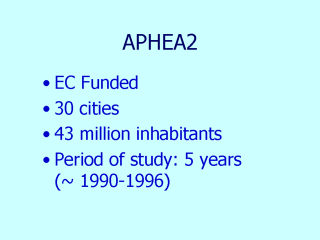 |
In the second phase of the
project, APHEA2, 30 European cities participated, with more complete information about
exposure and other variables. This has enabled the assessment of the consistency of the
associations, and a better control of confounding and effect modification. For
particulates, the relationship with mortality showed an increase of 0.6 per cent in the
daily number of deaths for an increase of 10 m g/m3 in black
smoke, and the same for PM10. When effect modification was investigated, cities with
average levels of NO2, warm climate, and low standardised mortality rates showed higher
effects. (Katsouyanni et al., 2001). For respiratory admissions the estimates showed
around 1 per cent increase for PM10 and smaller for black smoke (Atkinson et al., 2001a).
On the contrary, black smoke presented a clearer association with cardiovascular
admissions than PM10, 1.1 percent and 0.5, respectively (Le Tertre et al., 2002). |
